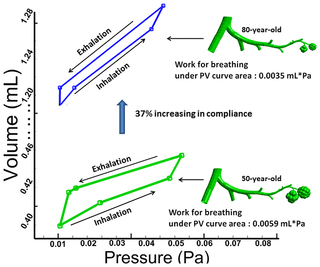PLOS ONE ( IF 2.9 ) Pub Date : 2017-08-28 , DOI: 10.1371/journal.pone.0183654 JongWon Kim , Rebecca L. Heise , Angela M. Reynolds , Ramana M. Pidaparti

|
Background and objective
The mortality rate for patients requiring mechanical ventilation is about 35% and this rate increases to about 53% for the elderly. In general, with increasing age, the dynamic lung function and respiratory mechanics are compromised, and several experiments are being conducted to estimate these changes and understand the underlying mechanisms to better treat elderly patients.
Materials and methods
Human tracheobronchial (G1 ~ G9), bronchioles (G10 ~ G22) and alveolar sacs (G23) geometric models were developed based on reported anatomical dimensions for a 50 and an 80-year-old subject. The aged model was developed by altering the geometry and material properties of the model developed for the 50-year-old. Computational simulations using coupled fluid-solid analysis were performed for geometric models of bronchioles and alveolar sacs under mechanical ventilation to estimate the airflow and lung function characteristics.
Findings
The airway mechanical characteristics decreased with aging, specifically a 38% pressure drop was observed for the 80-year-old as compared to the 50-year-old. The shear stress on airway walls increased with aging and the highest shear stress was observed in the 80-year-old during inhalation. A 50% increase in peak strain was observed for the 80-year-old as compared to the 50-year-old during exhalation. The simulation results indicate that there is a 41% increase in lung compliance and a 35%-50% change in airway mechanical characteristics for the 80-year-old in comparison to the 50-year-old. Overall, the airway mechanical characteristics as well as lung function are compromised due to aging.
Conclusion
Our study demonstrates and quantifies the effects of aging on the airflow dynamics and lung capacity. These changes in the aging lung are important considerations for mechanical ventilation parameters in elderly patients. Realistic geometry and material properties need to be included in the computational models in future studies.
中文翻译:

衰老对人体细支气管气流动力学和肺功能的影响
背景和目标
需要机械通气的患者的死亡率约为35%,而老年人的死亡率则增至约53%。通常,随着年龄的增长,动态肺功能和呼吸力学会受到损害,目前正在进行一些实验以评估这些变化并了解更好地治疗老年患者的潜在机制。
材料和方法
根据报道的50岁和80岁受试者的解剖学尺寸,开发了人类气管支气管(G1〜G9),细支气管(G10〜G22)和肺泡囊(G23)的几何模型。通过更改为50岁开发的模型的几何形状和材料属性来开发老化的模型。在机械通气条件下,对细支气管和肺泡囊的几何模型进行了使用流固耦合分析的计算模拟,以评估气流和肺功能特征。
发现
气道的机械特性随着年龄的增长而下降,特别是与80岁的人相比,80岁的人观察到了38%的压降。呼吸道壁上的剪切应力随着年龄的增长而增加,并且在吸入过程中在80岁的老人中观察到最高的剪切应力。与呼气期间的50岁相比,与80岁相比,80岁的峰值应变增加了50%。模拟结果表明,与50岁的人相比,80岁的人的肺顺应性增加了41%,呼吸道机械特性变化了35%-50%。总体而言,由于衰老,气道的机械特性以及肺功能受到损害。
结论
我们的研究证明并量化了衰老对气流动力学和肺活量的影响。肺部衰老的这些变化是老年患者机械通气参数的重要考虑因素。在以后的研究中,实际的几何形状和材料属性需要包含在计算模型中。

































 京公网安备 11010802027423号
京公网安备 11010802027423号